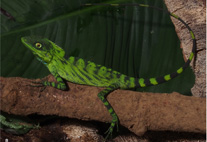Abstract
We describe three new species of Pseudocalotes from the Bukit Barisan Range of southern Sumatra, Indonesia. Pseudocalotes cybelidermus, P. guttalineatus, and P. rhammanotus differ from most congeners in having serrate dorsal crests that extend to the base of the tail and a dorsolateral series of enlarged heavily keeled scales. In these new species, subdigital lamellae of Toe III have prominent preaxial keels and lack or have greatly reduced postaxial keels. In contrast, P. rhammanotus resembles P. tympanistriga by having bicarinate subdigital lamellae at the base of Toe III. Like most congeners, these new species appear to be restricted to humid forests above 1000 m. We report several new morphological characters for Pseudocalotes and discuss their diagnostic value. Future systematic studies of this genus should assess presence/absence of interparietals, four different kinds of modified scales on the neck, a dorsolateral series of heavily keeled scales, and unicarinate lamellae under the distal phalanges of most fingers and toes. Our comparisons among congeners demonstrate the diagnostic value of width of the gap between the nuchal and dorsal crests and frequency data for contact between the nasal and supralabials and between the postmentals and infralabials. Finally, we discuss variation in morphology of subdigital lamellae at the base of Toe III and describe new conditions intermediate between the serrate fringe of most Indochinese species and the bicarinate lamellae of the P. tympanistriga.

